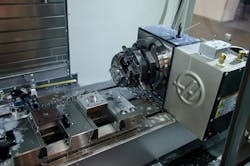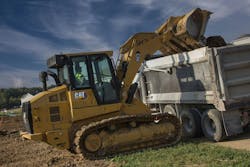So That Happened: Haas Cuts California Manufacturing Because of Tariffs
Editor’s note: Welcome to So That Happened, our editors’ takes on things going on in the manufacturing world that deserve some extra attention. This will appear regularly in the Member’s Only section of the site.
Industrial Might for 100 Years
Guess who is celebrating a centennial in 2025? It's Caterpillar Inc., which officially turns 100 on April 15. The $67 billion manufacturer of construction and mining equipment dates its start to 1925 with the merger of the Holt Manufacturing Co. and the C.L. Best Tractor Co., which gave birth to the Caterpillar Tractor Co.
And the origin of the Caterpillar name? You can point to an innovation by one of Caterpillar’s founders, Benjamin Holt, who was trying to make it easier for steam tractors to traverse soggy soil as farmers prepared fields for crops. In his efforts, Holt removed the rear wheels of a tractor, replaced them with a pair of “tracks” he designed. As the story goes, the company photographer described the movement of the modified machine as crawling like a big caterpillar. Holt got a trademark on the name Caterpillar in 1910, and when the two manufacturers merged, that’s the company name they embraced.
Caterpillar has been celebrating its centennial with events around the globe since the start of the year. Happy anniversary!
—Jill Jusko
Building EVs on a Clean Slate
Can Jeff Bezos do what a hatful of well-funded startups as well as Elon Musk haven’t been able to?
Sean O’Kane on Tuesday reported for TechCrunch that the Amazon founder has been leading the development of Slate, a skunkworks electric-vehicle company that’s aiming to build a two-seat pickup truck that would sell for roughly $25,000—which just so happens to be the price point for the entry-level Tesla Musk long aimed to build but abandoned last year, calling the idea “pointless” given Tesla’s plans for robotaxis.
The Slate team’s goal is to get this vehicle—inspired at its core by the Ford Model T and Volkswagen Beetle of decades past—into production by the end of next year. O’Kane dug deep into the Michigan-headquartered venture’s paper trail, which “is shot through with Amazon DNA” and includes a vision of a manufacturing plant in the Indianapolis area and funding from the controlling owner of the Los Angeles Dodgers.
Among the many noteworthy details of TechCrunch’s piece is that Slate plans to let buyers customize their trucks to a high degree and, inspired by the brand affinity approach of Harley-Davidson and others, market a range of “lifestyle and personalization” accessories. You can catch up on those details and much more right here.
—Geert De Lombaerde
New Partnership Unites Women in Industry
The Women in Manufacturing Association (WiM) and the Society of Women Engineers (SWE) have recently announced a new collaboration to further empower women in historically male-dominated industries. The partnership seeks to connect the two communities through shared access to learning opportunities, professional networks and other resources.
“Our theme this year is 'Together, We Rise,' a fitting sentiment for this new partnership and the promise of what we can accomplish in the years ahead,” says Karen Horting, CEO and executive director of SWE. “This partnership will further elevate the impact of both organizations by uniting professionals across manufacturing and all of engineering, encouraging cross-sector collaboration and strengthening efforts to ensure women are recognized as vital contributors to manufacturing and engineering success.”
Both organizations are celebrating significant anniversaries this year, with WiM celebrating 15 years and SWE turning 75. “The work of both our organizations is mission-critical to the industry and women engineers worldwide — now, more than ever,” Horting says.
WiM and SWE are offering a special discount for those who purchase memberships to both organizations to celebrate the new collaboration. “This collaboration will help us strengthen our mission of promoting, supporting and inspiring women who have chosen a career in the manufacturing space,” says Allison Grealis, founder and president of WiM.
—Anna Smith
Needled by Tariffs—Again
World Emblem, an embroidered badge and logo manufacturer whose COO we interviewed two weeks ago, saw a sliver shaved off the anvil of tariff heaviness last week with the announcement that compliant USMCA-made goods are exempt from new tariffs. The company makes the bulk of its patches in the United States and Mexico, shipped to customers like FedEx and Cintas in the U.S., Mexico and Canada.
But wait … Even if that tariff policy holds, World Emblem doesn’t have things sewed up yet. Last September, the company bought Hero’s Pride, an emblem maker with manufacturing in China, Taiwan and Vietnam.
Diversifying manufacturing locations seemed like a good idea at the time, but at the moment those goods shipped to the U.S. incur an additional cost (up to 104% for goods from China) under President Donald Trump’s most recent tariffs. Asian-made patches now account for about 25% of the company’s business.
“Do you move it to Mexico and do it all there?” Carr wondered. “The other strategy would be to absorb the tariffs and try to do a market grab and take that away from our competitors.”
“I am dizzy,” he admitted, adding that any production brought to the U.S. would likely take into account automation, robotics and generative AI before increasing jobs. “But I’m in the same boat everybody else is in.”
—Laura Putre
Procter & Gamble Picks Vanilla Suede as its 2025 “Scent of the Year”
In a celebration of sensory pleasures no less prestigious than Pantone’s own Color of the Year, Procter & Gamble announced that Febreze has named its 2025 Scent of the Year: Vanilla Suede, a complex blend of mahogany, amber, and smoked vanilla.
In an April 9 announcement, the fragrance company’s master perfumer, Rafael Trujillo, characterized Vanilla Suede as the odor of choice for turbulent times that sees scared sniffers staying in.
“Amidst the chaos of everyday life, we’re seeing a rise in self-indulgence and a desire to take back control of our spaces,” Trujillo said. “People are looking for reasons to spend more time at home, whether that means hosting friends or curating the perfect night in.”
Trujillo, in cooperation with P&G’s Febreze Fragrance Group, picked the scent based on company research and forecasts, which show Americans “collectively focusing on the desire to slow down and take refuge in our homes,” which reportedly inspired the company’s lead perfumer, Michelle Hagan, to develop the scent.
Previously honored scents include 2024’s “Romance & Desire,” a fragrance of champagne and rose petals, and 2023’s “Mountain,” which smells of alpine wildflowers and cedar.
—Ryan Secard
Haas Reduces Production, Slashes Overtime in California
With the vast majority of global machine tools coming out of Europe and Asia, California-based Haas Automation might sound like it’s in a perfect position to benefit from tariffs placed on imports that President Donald Trump says will kickstart American manufacturing.
However, any longer-term reshoring is way off in the distance. Instead, Haas is facing an immediate pullback in production from its manufacturing customers as they weigh increases in raw materials and components prices.
“In recent days, we’ve seen a dramatic decrease in demand for our machine tools from both domestic and foreign customers,” Haas automations official said. “Out of caution, we have reduced production and eliminated overtime at our sole manufacturing plant in Oxnard, California, where we employ 1,700 workers and have been in operation since 1983. We have also halted hiring and put new employment requisitions on hold.”
Because reshoring will require new equipment, Haas officials said they’re worried that the administration could slash tariffs on machines from Taiwan (companies such as YCM and Hartford), Japan (Okuma, Makino) and Korea (DN Solutions, Hwacheon) to avoid making manufacturing investments in the U.S. more expensive.
Worse, Haas imports some of the materials and components it uses in its machine tools, so tariff breaks for Asian machine tool makers could give them a major cost advantage over American-produced machines.
“Without a corresponding reduction in tariff rates for imported raw materials and components into the U.S., such a scenario would be catastrophic to the $5 billion U.S. machine tool industry, which is a key component of U.S. national security,” Haas officials said.
—Robert Schoenberger
About the Author
Jill Jusko
Bio: Jill Jusko is executive editor for IndustryWeek. She has been writing about manufacturing operations leadership for more than 20 years. Her coverage spotlights companies that are in pursuit of world-class results in quality, productivity, cost and other benchmarks by implementing the latest continuous improvement and lean/Six-Sigma strategies. Jill also coordinates IndustryWeek’s Best Plants Awards Program, which annually salutes the leading manufacturing facilities in North America.
Have a story idea? Send it to [email protected].
Geert De Lombaerde
Senior Editor
A native of Belgium, Geert De Lombaerde has been in business journalism since the mid-1990s and writes about public companies, markets and economic trends for Endeavor Business Media publications, focusing on IndustryWeek, FleetOwner, Oil & Gas Journal, T&D World and Healthcare Innovation. He also curates the twice-monthly Market Moves Strategy newsletter that showcases Endeavor stories on strategy, leadership and investment and contributes to other Market Moves newsletters.
With a degree in journalism from the University of Missouri, he began his reporting career at the Business Courier in Cincinnati in 1997, initially covering retail and the courts before shifting to banking, insurance and investing. He later was managing editor and editor of the Nashville Business Journal before being named editor of the Nashville Post in early 2008. He led a team that helped grow the Post's online traffic more than fivefold before joining Endeavor in September 2021.
Anna Smith
News Editor
News Editor
LinkedIn: https://www.linkedin.com/in/anna-m-smith/
Bio: Anna Smith joined IndustryWeek in 2021. She handles IW’s daily newsletters and breaking news of interest to the manufacturing industry. Anna was previously an editorial assistant at New Equipment Digest, Material Handling & Logistics and other publications.

Laura Putre
Senior Editor, IndustryWeek
As senior editor, Laura Putre works with IndustryWeek's editorial contributors and reports on leadership and the automotive industry as they relate to manufacturing. She joined IndustryWeek in 2015 as a staff writer covering workforce issues.
Prior to IndustryWeek, Laura reported on the healthcare industry and covered local news. She was the editor of the Chicago Journal and a staff writer for Cleveland Scene. Her national bylines include The Guardian, Slate, Pacific-Standard and The Root.
Laura was a National Press Foundation fellow in 2022.
Got a story idea? Reach out to Laura at [email protected]
Ryan Secard
Associate Editor
Ryan Secard joined Endeavor B2B in 2020 as a news editor for IndustryWeek. He currently contributes to IW, American Machinist, Foundry Management & Technology, and Plant Services on breaking manufacturing news, new products, plant openings and closures, and labor issues in manufacturing.
Robert Schoenberger
Editor-in-Chief
LinkedIn: linkedin.com/in/robert-schoenberger-4326b810
Bio: Robert Schoenberger has been writing about manufacturing technology in one form or another since the late 1990s. He began his career in newspapers in South Texas and has worked for The Clarion-Ledger in Jackson, Mississippi; The Courier-Journal in Louisville, Kentucky; and The Plain Dealer in Cleveland where he spent more than six years as the automotive reporter. In 2014, he launched Today's Motor Vehicles (now EV Manufacturing & Design), a magazine focusing on design and manufacturing topics within the automotive and commercial truck worlds. He joined IndustryWeek in late 2021.





